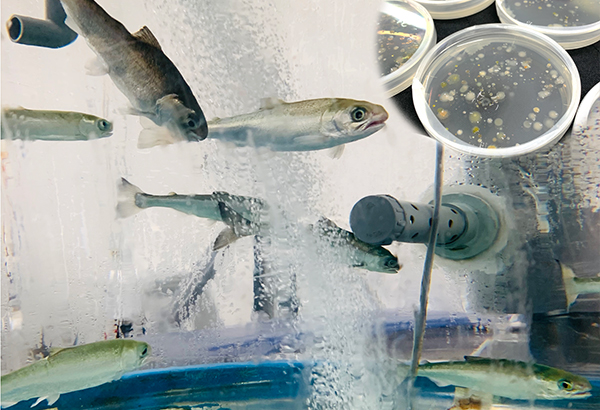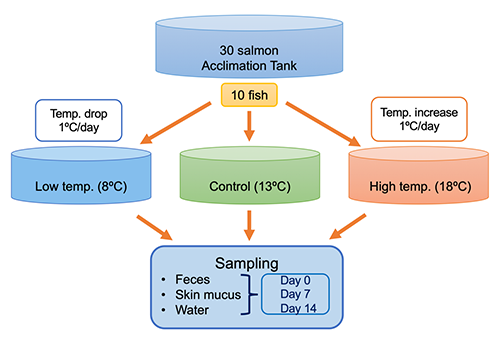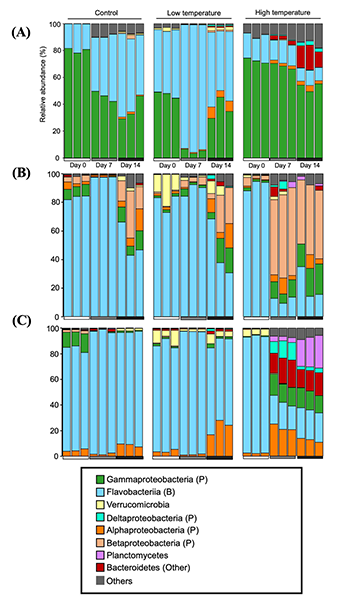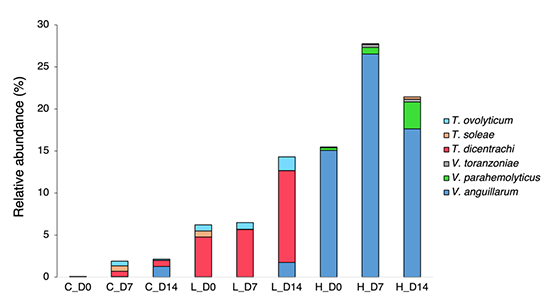Does climate change disrupt salmon microbiota?
27 September, 2022
Koji Hamasaki (Marine Ecosystem Science, Professor)
Subrata Kumar Ghosh (Marine Ecosystem Science, PhD candidate)
Shuji Goto (Marine Ecosystem Science, Research scientist)
Marty Kwok-Shing Wong (Marine Bioscience, Research scientist)
Susumu Hyodo (Marine Bioscience, Professor)

Microorganisms that live in the digestive tract and epidermis of fish are thought to play a significant role in fish health. Changes in the marine environment due to ongoing climate change may impede the physiological homeostasis of fish by disrupting the fish microbiota*1, but we have not obtained a sufficient answer yet. A research group led by Professor Hamasaki and a graduate student Mr. Ghosh of the Atmosphere and Ocean Research Institute, The University of Tokyo conducted rearing experiments on chum salmon*2 (Oncorhynchus keta), and found that increases or decreases in water temperature changed the community balance of microbiota in intestine and epidermis, leading to the propagation of potentially pathogenic bacteria. In particular, the gut microbiota was strongly affected by water temperature changes. The study implied that changes in the marine environment potentially affected salmon survival not only directly on cell metabolism, but also indirectly through changes in the gut and skin microbiota.
Background
The gut and skin microbiota of fish often interact strongly with the host and play an important role in maintaining homeostasis. It has been reported that the community structure of these microbiota is disturbed by changes in environmental factors. Chum salmon, which are familiar to the Japanese, migrate widely from rivers to the open ocean and they experience diverse environments throughout their lives. It is not known how changes in the marine environment due to climate change would affect the growth and survival of these migratory fish, especially on the effects of disruption of the gut and skin microbiota. The purpose of this study was to clarify the temperature effects on the community structure and formation process of chum salmon microbiota.
Results
Chum salmon (Oncorhynchus keta) that was hatched and reared in laboratory aquarium for two years was used in the experiment. The gut and skin microbiota and the rearing water microbiota were compared under different water temperature conditions (Fig. 1). As a result, it was found that the gut microbiota of chum salmon was mainly composed of facultative anaerobic bacteria, the genus Alivibrio of the class Gammaproteobacteria (Fig. 2A). It was also found that the relative abundance of bacterial species of the genus Vibrio and the genus Tenacibaculum increased under high and low temperature conditions, respectively (Fig. 3). As these bacterial species are pathogenic strains and they may cause opportunistic infections, these changes can affect the host's immune system through disease development. On the other hand, the skin microbiota was dominated by the genus Flavobacteria of the class Flavobacteria, and the class Betaproteobacteria increased in the low temperature condition (Fig. 2B). Betaproteobacteria are often considered stress-specific biomarkers, suggesting chum salmon in cold water environments experienced higher stress that leads to the shift of microbiota. We also analyzed the extent to which the microbiota in the rearing water could influence the formation of the chum salmon microbiota, and found distinct clustering patterns among the gut, skin, and rearing water microbiota. Microbiota from different parts of fish formed distinct community structures specific to the environments. Furthermore, phylogenetic relatedness within the community was analyzed to test whether a deterministic process due to environmental selection or a random stochastic process is important for the microbiota formation. As a result, it was found that the formation of the gut microbiota is greatly influenced by environmental selection, while the formation of the skin microbiota was stochastic rather than affected by environmental selection.
Social significance and future perspectives
The results of this study indicated that changes of water temperature not only directly affect the survival of chum salmon, but also indirectly affect it through changes of the gut and skin microbiota. At present, the role of the gut and skin microbiota in maintaining the physiological homeostasis of chum salmon is unknown, and basic knowledge is lacking. In the future, it is necessary to conduct further research on the functional complementary relationships and interactions between fish and microbiota. It is expected that accumulation of these knowledges will lead to better understanding of the impact of climate change on important fishery resources such as chum salmon, and thus better resource conservation measures can be implemented.

Fig.1.The scheme of temperature modulation experiment of chum salmon (Oncorhynchus keta). The gut, skin, and rearing water microbiota were sampled after rearing at 3 different temperatures (13℃±5℃) for 7 and 14 day.

Fig.2. Microbial community structures (class level) of the (A) gut (B) skin (C) rearing water

Fig.3. Relative abundance of pathogenic bacteria at Low temperature (8℃) and high temperature (18℃)
Journal: Frontiers in Marine Science (On-line September 27, 2022)
Title of paper: Temperature modulation alters the gut and skin microbial profiles of chum salmon (Oncorhynchus keta)
Authors: Subrata Kumar Ghosh*, Marty Kwok-Shing Wong, Susumu Hyodo, Shuji Goto, Koji Hamasaki
DOI: https://doi.org/10.3389/fmars.2022.1027621
URL: https://www.frontiersin.org/articles/10.3389/fmars.2022.1027621/full
Media contact
Koji Hamasaki
hamasaki[at]aori.u-tokyo.ac.jp
Glossary
*1 Microbial assemblages living in nature and consisting of diverse species
*2 The most popular salmon in Japan. In autumn, they swim upstream in rivers in Hokkaido and the Tohoku region to spawn. After hatching, they go out to the sea, grow while migrating in the North Pacific Ocean, and return to the rivers of their hatching when they reach maturity.
![]()



